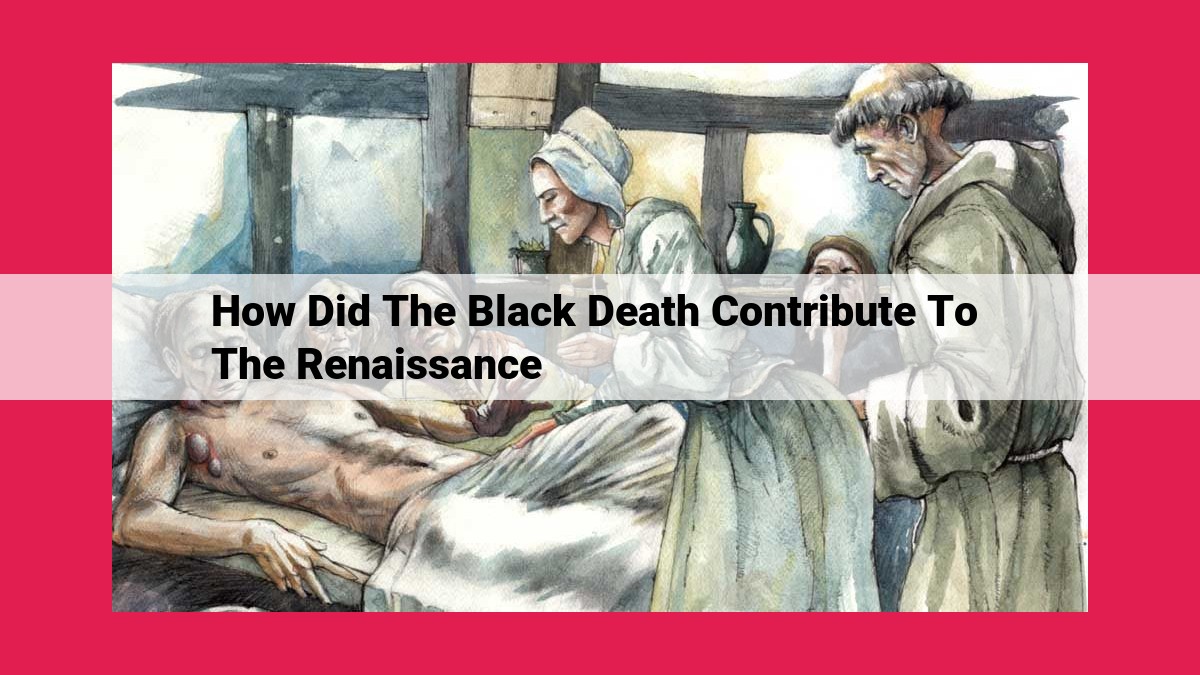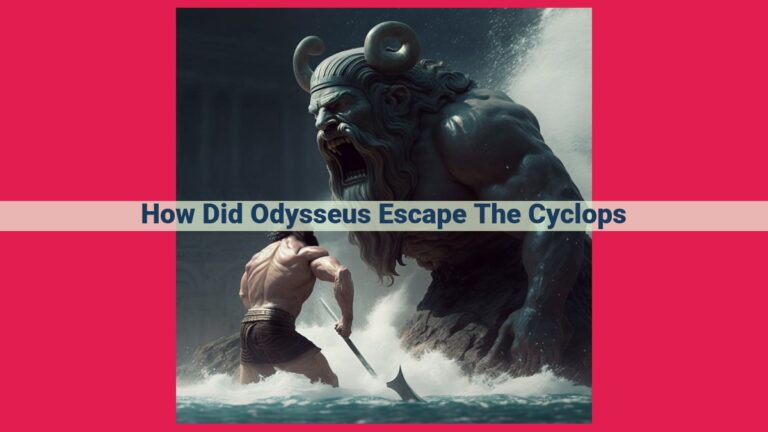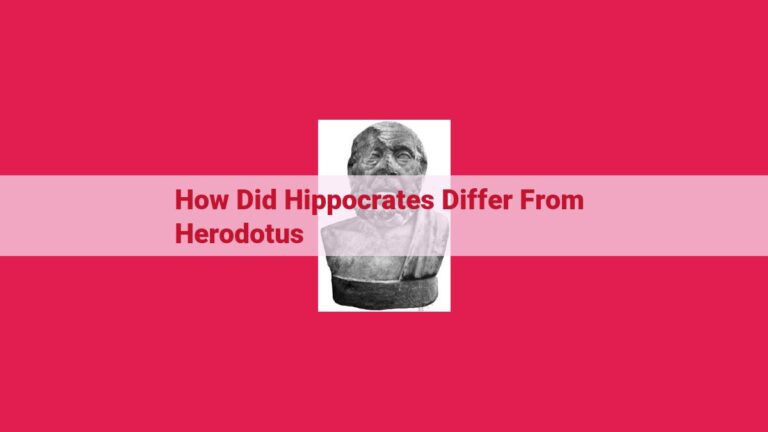The Impact Of The Black Death On The Renaissance: A Catalyst For Innovation And Cultural Flourishing

The Black Death’s impact on the Renaissance was multifaceted: the massive population loss and subsequent labor shortage spurred economic growth and innovation, disrupting feudal structures and facilitating social mobility. It sparked humanism, encouraging reason and observation, and inspired artistic innovations. Wealthy patrons supported artists and scholars, leading to a cultural and artistic flourishing that defined the Renaissance.
The Devastating Demographic Impact
- Describe the massive population loss caused by the Black Death and its consequences.
The Devastating Demographic Impact of the Black Death
In the annals of history, the Black Death stands as a cataclysmic event that forever reshaped human society. This bubonic plague, unleashed upon Europe in the mid-14th century, claimed an estimated one-third to one-half of the continent’s population, leaving behind a trail of devastation and irrevocable change.
The demographic impact was profound and immediate. Entire villages were decimated, and major cities lost vast numbers of inhabitants. In Florence, the death toll reached an astounding 50%. The countryside, once teeming with serfs and peasants, became sparsely populated and desolate.
This massive population loss had far-reaching consequences. Not only did it disrupt economies, but it also overturned feudal power structures and sparked a remarkable era of social and cultural upheaval. With fewer workers toiling the land, labor became scarcer and wages soared, leading to an economic boom and a transformation of society that would pave the way for the Renaissance and the emergence of the modern world.
The Black Death: A Catalyst for Unparalleled Economic Transformation
The Black Death, an unrelenting pandemic that ravaged Europe in the 14th century, left an indelible mark on human history. While its devastating demographic impact is often emphasized, the economic consequences it triggered were equally profound.
A Surge in Wages and Economic Growth: Labor Scarcity’s Unexpected Legacy
As the Black Death swept through Europe, it claimed countless lives, leaving a void in the labor force. This unprecedented labor shortage had a surprising effect: wages soared. With fewer workers available, employers were forced to compete for the services of the remaining workforce. The resulting surge in wages significantly improved the economic status of the lower classes.
Stimulating Economic Growth: A Ripple Effect of Labor Shortages
The increased wages had a ripple effect throughout the economy. Workers could now afford to purchase more goods and services, stimulating demand and encouraging businesses to expand. This surge in economic activity led to a period of rapid economic growth. As businesses thrived, they invested in new technologies and innovations, further propelling economic progress.
A Precursor to Capitalism: The Erosion of Feudalism
The Black Death’s impact on the labor market also played a pivotal role in the decline of feudalism. With wages rising and serfs in high demand, the rigid feudal system began to crumble. Peasants were emboldened to leave their feudal lords and seek better opportunities in towns and cities. The rise of a wage-earning class laid the foundation for the emergence of capitalism.
The Economic Renaissance: Increased Wages and a Thriving Economy in the Wake of the Black Death
The devastating toll of the Black Death on Europe’s population created a paradox: while it decimated lives, it also ignited a spark of economic transformation. The labor shortage that followed the pandemic led to a surge in wages for the surviving workforce. Suddenly, ordinary laborers possessed newfound bargaining power, demanding higher compensation.
This increase in income had a ripple effect throughout society. With their increased wealth, workers could purchase more goods and services, stimulating economic growth. This purchasing power sparked innovation, as businesses, eager to meet the demands of an affluent population, invested in new technologies.
One major technological innovation that emerged from this period was the printing press. Invented by Johannes Gutenberg in the mid-15th century, the printing press revolutionized the dissemination of knowledge and information. It made books and other written materials more readily available, fostering education and the spread of ideas.
The economic boom also led to a restructuring of the class system. The decline of the feudal system, which had previously bound peasants to the land, created opportunities for social mobility. Skilled laborers and merchants could now accumulate wealth and climb the social ladder.
This economic transformation was a major catalyst for the rise of capitalism. The accumulation of wealth by merchants and artisans led to the development of markets and wage labor. The profit motive became a driving force in the economy, as individuals and businesses sought to increase their earnings.
The positive economic impact of the Black Death was a testament to the resilience and ingenuity of the human spirit. In the face of adversity, people adapted and innovated, creating a foundation for future economic prosperity.
Social Mobility and a Changing Class Structure
The Black Death had a profound impact on the rigid feudal hierarchies that dominated medieval Europe. With the devastation it caused, traditional social structures were weakened, creating unprecedented opportunities for social advancement.
Serfs, once bound to the land, found themselves in high demand as the labor shortage forced landowners to compete for their services. This led to rising wages and increased freedom for these former peasants. They gained the ability to negotiate their conditions of employment and, in some cases, even move up the social ladder.
Craftsmen and artisans, who possessed specialized skills, also benefited from the shortage of skilled labor. Their work became highly valued, and they were able to command higher wages and enjoy greater social status. This paved the way for the rise of a merchant class, which accrued wealth and influence through trade and commerce.
The weakening of the feudal system and the emergence of a more fluid social structure allowed individuals from all walks of life to achieve higher ranks. Those with ambition and talent could rise through the ranks, regardless of their birth. This created a more dynamic society and laid the foundation for the eventual development of capitalism.
The Decline of Feudalism and the Rise of Capitalism: A Black Death Transformation
In the wake of the devastating Black Death, the feudal system that had dominated Europe for centuries began to crumble. The severe population loss left a labor shortage, forcing landowners to increase wages and compete for workers. This economic disruption created opportunities for peasants and serfs to improve their lives.
Wage labor became more common, with workers now able to negotiate for better pay and freedom of movement. Market economies emerged, as towns and cities grew and trade flourished. Landlords found their power waning, as their control over peasants diminished.
The rise of capitalism was fueled by this shift from feudalism to a market-based system. Merchants, artisans, and entrepreneurs gained wealth and influence, as they capitalized on the economic opportunities created by the Black Death.
This transformation had profound implications for the social and economic development of Europe. Feudalism’s rigid class structure gave way to a more fluid society where economic success and individual initiative were valued.
The decline of feudalism and the rise of capitalism set the stage for the emergence of modern Europe, characterized by economic growth, social mobility, and the rise of nation-states.
The Black Death’s Unforeseen Renaissance: A Surge in Humanism and Intellectualism
The devastating Black Death of the 14th century, while inflicting unimaginable suffering, paradoxically ignited a transformative flame within European society. Amidst the chaos and loss, a profound shift occurred, heralding the dawn of humanism and an intellectual revolution.
The Great Plague, as it was then known, left a devastating demographic void, shattering the rigid feudal structures that had long defined medieval Europe. With labor in short supply, wages skyrocketed, empowering those who survived. This economic upheaval created space for individuals to pursue their own interests, fostering a newfound appreciation for human potential.
Simultaneously, the death of so many religious authorities undermined the dominant ecclesiastical worldview. People began to question traditional beliefs and seek answers in the realms of reason and observation. This thirst for knowledge sparked a revival of classical learning and a growing fascination with the natural world.
Scholars and artists alike embraced the humanist philosophy, emphasizing human agency, rationality, and the pursuit of secular knowledge. The works of ancient Greek and Roman philosophers, long forgotten, were rediscovered and celebrated as beacons of wisdom.
The resulting cultural explosion is what we now refer to as the Renaissance. Humanist thinkers, such as Erasmus of Rotterdam and Niccolò Machiavelli, challenged prevailing norms and promoted critical thinking. They emphasized the importance of individual judgment and the pursuit of earthly goals.
The new intellectual climate had a profound impact on the arts, as well. Artists like Leonardo da Vinci and Michelangelo were inspired by the humanist focus on human anatomy and the natural world. They developed innovative techniques, such as perspective and chiaroscuro, that breathed life and realism into their masterpieces.
The rise of humanism and intellectual renewal during the Renaissance was a testament to the resilience and adaptability of the human spirit. Amidst the despair and devastation of the Black Death, a seed of renewal was planted, leading to an unprecedented flowering of culture, science, and artistic achievement.
Artistic Innovations and New Techniques: The Black Death’s Cultural Legacy
In the aftermath of the devastating Black Death, Europe witnessed a remarkable artistic renaissance. This period marked a departure from the stylized, symbolic art of the Middle Ages and ushered in an era of realism and scientific observation.
The Black Death’s Impact on Art
The mass loss of life during the Black Death had a profound impact on the human psyche. The uncertainty and fear of death inspired a new appreciation for the beauty and delicacy of life. This shift in perspective found expression in art, leading to a greater focus on naturalism, emotion, and individualism.
Artistic Innovations
- Perspective: Artists experimented with linear perspective to create the illusion of depth. This technique allowed them to depict three-dimensional scenes that resembled the world as it was seen through the human eye.
- Realism: The emphasis on realism extended beyond perspective to all aspects of art. Artists sought to depict everyday life, ordinary people, and familiar objects with meticulous detail and accuracy.
- Chiaroscuro: Artists used chiaroscuro (light and shadow) to create dramatic effects and heighten the emotions expressed in their works. This technique allowed them to sculpt figures and create a sense of depth and volume.
The Rise of Individualism
The disruption of the feudal system and the loosening of social hierarchies gave rise to a new sense of individualism. Artists began to sign their works and seek recognition for their unique talents. This marked a significant departure from the anonymous art of the Middle Ages.
The Black Death left an indelible mark on European art. It inspired artistic innovations, fostered a new appreciation for realism, and paved the way for the rise of individualism. The cultural legacy of the Black Death lives on in the masterpieces of the Renaissance and continues to influence and inspire artists to this day.
Patronage of the Arts and the Flourishing of Culture
In the wake of the devastation wrought by the Black Death, a remarkable phenomenon emerged: the patronage of the arts by wealthy individuals and cities. Amidst the social and economic upheaval, a surge in artistic creativity and cultural production took hold.
With the decline of feudalism, newfound wealth and influence flowed into the hands of merchants and nobles. Inspired by the humanist ideals that characterized the Renaissance, these patrons recognized the importance of learning and culture in a changing world.
Individuals such as Lorenzo de’ Medici in Florence and Isabella d’Este in Mantua became renowned patrons, surrounding themselves with artists, scholars, and intellectuals. They commissioned groundbreaking works of art, supported scientific research, and fostered the exchange of ideas.
Cities too played a vital role in the patronage of the arts. Civic governments in wealthy urban centers such as Venice and Ghent allocated funds for cultural projects, including painting, architecture, and music. By supporting public commissions, cities not only beautified their environments but also promoted a sense of civic pride and cultural identity.
This generous patronage had a transformative impact on the cultural landscape. Artists were freed from the confines of traditional courtly patronage and guild restrictions. They experimented with new ideas, techniques, and styles, resulting in a proliferation of masterworks.
From the realistic portraits of Jan van Eyck to the innovative architectural designs of Brunelleschi, the art of the Renaissance flourished under the patronage of the wealthy and powerful. The cultural legacy of this time continues to inspire and enrich the world today.





